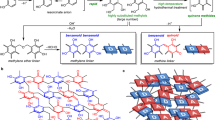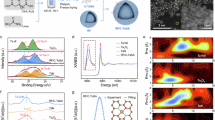Abstract
Leading strategies for the capture of CO2 from point sources and directly from the atmosphere face high energy costs for thermal sorbent regeneration. Photochemical processes, driven by sunlight as the sole external stimulus, offer a promising alternative. Despite many reported examples of light-induced pH swings using metastable photoacids, the complementary mode of operation, using photoswitchable bases, has not been extensively considered. This is due in part to the rarity of photobases that can support large, reversible pH jumps in water. Here we report the design of fluorenol-based Arrhenius photobases that take advantage of excited-state aromaticity and ground-state antiaromaticity to generate large basicity swings with high reversibility. The system is oxygen stable, can be driven by natural sunlight and captures/concentrates CO2 from ambient air. We elucidated the mechanism of C–O dissociation using transient absorption spectroscopy to understand the high efficiency of hydroxide release. This study provides a framework for the design of photoreversible aqueous bases and guiding principles for their use in solar-powered CO2 management.

This is a preview of subscription content, access via your institution
Access options
Access Nature and 54 other Nature Portfolio journals
Get Nature+, our best-value online-access subscription
$32.99 / 30 days
cancel any time
Subscribe to this journal
Receive 12 print issues and online access
$259.00 per year
only $21.58 per issue
Buy this article
- Purchase on SpringerLink
- Instant access to full article PDF
Prices may be subject to local taxes which are calculated during checkout






Similar content being viewed by others
Data availability
All data supporting the findings of this study are available within the article and its Supplementary Information. Source data are provided with this paper.
References
Minx, J. C. et al. Negative emissions—part 1: research landscape and synthesis. Environ. Res. Lett. 13, 063001 (2018).
Gulev, S. K. et al. Climate Change 2021: The Physical Science Basis Summary for Policymakers Ch. 1–4 (Cambridge Univ. Press, 2021).
Schleussner, C.-F. et al. Overconfidence in climate overshoot. Nature 634, 366–373 (2024).
Leung, D. Y. C., Caramanna, G. & Mercedes, M. V. M. An overview of current status of carbon dioxide capture and storage technologies. Renew. Sustain. Energy Rev. 39, 426–443 (2014).
Gibbins, J. & Chalmers, H. Carbon capture and storage. Energy Policy 36, 4317–4322 (2015).
Hanna, R., Abdulla, A., Xu, Y. & Victor, D. G. Emergency deployment of direct air capture as a response to the climate crisis. Nat. Commun. 12, 368 (2025).
Sanz-Pérez, E. S., Murdock, C. R., Didas, S. A. & Jones, C. W. Direct capture of CO2 from ambient air. Chem. Rev. 116, 11840–11876 (2016).
Keith, D. W., Holmes, G., St. Angelo, D. & Heidel, K. A process for capturing CO2 from the atmosphere. Joule 2, 1573–1594 (2018).
Rochelle, G. T. Amine scrubbing for CO2 capture. Science 325, 1652–1654 (2011).
Ding, X., Chen, H., Li, J. & Zhou, T. Comparative techno-economic analysis of CO2 capture processes using blended amines. Carbon Capture Sci. Technol. 9, 100136 (2023).
Zito, A. M. et al. Electrochemical carbon dioxide capture and concentration. Chem. Rev. 123, 8069–8098 (2023).
Wang, T., Lackner, K. S. & Wright, A. Moisture swing sorbent for carbon dioxide capture from ambient air. Environ. Sci. Technol. 45, 6670–6675 (2011).
Lim, T. H., Foster, J. E., Ellis, B. R. & Skerlos, S. J. Microwave-based CO2 desorption for enhanced direct air capture: experimental validation and techno-economic perspectives. Environ. Res. Lett. 19, 034002 (2024).
Alfaraidi, A. M. et al. Reversible CO2 capture and on-demand release by an acidity-matched organic photoswitch. J. Am. Chem. Soc. 145, 26720–26727 (2023).
de Vries, A., Goloviznina, K., Reiter, M., Salanne, M. & Lukatskaya, M. R. Solvation-tuned photoacid as a stable light-driven pH switch for CO2 capture and release. Chem. Mater. 36, 1308–1317 (2024).
Cotton, D., Khuu, T., Takematsu, K., Delibas, B. & Dawlaty, J. M. Photoinduced carbon dioxide release via a metastable photoacid in a nonaqueous environment. J. Phys. Chem. Lett. 15, 7782–7787 (2024).
Premadasa, U. I. et al. Photochemically-driven CO2 release using a metastable-state photoacid for energy efficient direct air capture. Angew. Chem. Int. Ed. 62, e202304957 (2023).
Li, M., Irtem, E., Iglesias van Montfort, H. P., Abdinejad, M. & Burdyny, T. Energy comparison of sequential and integrated CO2 capture and electrochemical conversion. Nat. Commun. 13, 5398 (2022).
Sen, R., Goeppert, A., Kar, S. & Prakash, G. K. S. Hydroxide based integrated CO2 capture from air and conversion to methanol. J. Am. Chem. Soc. 142, 4544–4549 (2020).
Pei, Y., Zhang, B. & Lu, Y. Next nanotechnology carbon capture and utilization via electrochemistry, what’s next? Next Nanotechnol. 3–4, 100020 (2023).
Pang, S. et al. A phenazine-based high-capacity and high-stability electrochemical CO2 capture cell with coupled electricity storage. Nat. Energy 8, 1126–1136 (2023).
Seo, H. & Hatton, T. A. Electrochemical direct air capture of CO2 using neutral red as reversible redox-active material. Nat. Commun. 14, 313 (2023).
Jin, S., Wu, M., Jing, Y., Gordon, R. G. & Aziz, M. J. Low energy carbon capture via electrochemically induced pH swing with electrochemical rebalancing. Nat. Commun. 13, 2140 (2022).
Barlow, J. M. & Yang, J. W. Oxygen-stable electrochemical CO2 capture and concentration with quinones using alcohol additives. J. Am. Chem. Soc. 144, 14161–14169 (2022).
Wimberger, L. et al. Large, tunable, and reversible pH changes by merocyanine photoacids. J. Am. Chem. Soc. 143, 20758–20768 (2021).
Wilm, L. F. B. et al. Photoswitchable nitrogen superbases: using light for reversible carbon dioxide capture. Angew.Chem. Int. Ed. 61, e202112344 (2022).
Sheng, W. et al. Proton transfer ultrafast dynamics of a ‘super’ photobase. Angew. Chem. Int. Ed. 57, 14742–14746 (2018).
Han, G. R. et al. Shedding new light on an old molecule: quinophthalone displays uncommon N-to-O excited state intramolecular proton transfer (ESIPT) between photobases. Sci. Rep. 7, 3863 (2017).
Yucknovsky, A. & Amdursky, N. Controlling pH-sensitive chemical reactions pathways with light—a tale of two photobases: an Arrhenius and a Brønsted. Chem. Eur. J. 30, e202303767 (2024).
Voegtle, M. J. & Dawlaty, J. W. Can Brønsted photobases act as Lewis photobases? J. Am. Chem. Soc. 144, 28178–28184 (2022).
Gaillard, E., Fox, M. A. & Wan, P. A. Kinetic study of the photosolvolysis of 9-fluorenol. J. Am. Chem. Soc. 111, 2180–2186 (1989).
Blazek, A., Pungente, M., Krogh, E. & Wan, P. Photosolvolysis of 9-fluorenol derivatives in aqueous solution—exploratory studies of reactivity of photogenerated 9-fluorenyl cations. J. Photochem. Photobiol. A 64, 315–327 (1992).
Chahinez, A. et al. A long-lived fluorenyl cation: efficiency booster for uncaging and photobase properties. Phys. Chem. Chem. Phys. 24, 5294–5300 (2022).
Irie, M. Light-induced reversible pH change. J. Am. Chem. Soc. 105, 2078–2079 (1983).
Uda, R. M. & Takenaka, D. Malachite green leuco derivatives as photobase generators for initiating crosslinking and polymerization. Mater. Lett. 303, 130541 (2021).
Huajie, L. et al. Light-driven conformational switch of i-motif DNA. Angew. Chem. Int. Ed. 46, 2515–2517 (2007).
Carvalho, P. C., Uzunova, D. V., Da Silva, J. P., Nau, W. M. & Pischel, U. A photoinduced pH jump applied to drug release from cucurbit[7]uril. Chem. Commun. 47, 8793–8.795 (2011).
Hermanns, V. et al. Rethinking uncaging: a new antiaromatic photocage driven by a gain of resonance energy. Chem. Eur. J. 27, 14121–14127 (2021).
Abdellaoui, C. et al. A long-lived fluorenyl cation: efficiency booster for uncaging and photobase properties. Phys. Chem. Chem. Phys. 24, 5294–5300 (2022).
Reinfelds, M. et al. A new photocage derived from fluorene. Chem. Eur. J. 24, 13026–13035 (2018).
Müller, P. et al. [Ru(bpy)3]2+ as a reference in transient absorption spectroscopy: differential absorption coefficients for formation of the long-lived 3MLCT excited state. Photochem. Photobiol. Sci. 11, 10–13 (2012).
Yan, M., Lo, J. C., Edwards, J. T. & Baran, P. S. Radicals: reactive intermediates with translational potential. J. Am. Chem. Soc. 138, 12692–12714 (2016).
Wahidmurni et al. Photochemical formation and electrophilic reactivities of vinyl cations. Influence of substituents, anionic leaving groups, solvents, and excitation wavelength on photoheterolysis and photohomolysis of 1-(p-R-phenyl)-2-(2,2′-biphenyldiyl)vinyl halides. J. Phys. Chem. 98, 2588–2593 (2017).
Zhao, Y. & Truhlar, D. G. The M06 suite of density functionals for main group thermochemistry, thermochemical kinetics, noncovalent interactions, excited states, and transition elements: two new functionals and systematic testing of four M06-class functionals and 12 other functionals. Theor. Chem. Acc. 120, 215–241 (2008).
Frisch M. J. et al. Gaussian 16, Revision C.01 (Gaussian, 2016).
Weigend, F. & Ahlrichs, R. Balanced basis sets of split valence, triple zeta valence and quadruple zeta valence quality for H to Rn: design and assessment of accuracy. Phys. Chem. Chem. Phys. 7, 3297–3305 (2005).
Grimme, S., Antony, J., Ehrlich, S. & Krieg, H. A consistent and accurate ab initio parametrization of density functional dispersion correction (DFT-D) for the 94 elements H–Pu. J. Chem. Phys. 132, 154104 (2010).
Marenich, A. V., Cramer, C. J. & Truhlar, D. G. Universal solvation model based on solute electron density and on a continuum model of the solvent defined by the bulk dielectric constant and atomic surface tensions. J. Phys. Chem. B 113, 6378–6396 (2009).
Geuenich, D., Hess, K., Köhler, F. & Herges, R. Anisotropy of the induced current density (ACID), a general method to quantify and visualize electronic delocalization. Chem. Rev. 49, 3758–3772 (2005).
Fallah-Bagher-Shaidaei, H., Wannere, C. S., Corminboeuf, C., Puchta, R. & Schleyer, P. Which NICS aromaticity index for planar π rings is best? Org. Lett. 8, 6–9 (2006).
Keith, T. A. & Bader, R. F. W. Calculation of magnetic response properties using atoms in molecules. Chem. Phys. Lett. 194, 1–8 (1992).
Lu, T. & Chen, F. Multiwfn: a multifunctional wavefunction analyzer. J. Comput. Chem. 33, 580–592 (2011).
Li, Y. Energy Diagram Plotter CDXML 3.5.1. Zenodo https://doi.org/10.5281/zenodo.7187658 (2022).
Acknowledgements
R.Y.L. is grateful to the Corning Fund for Faculty Development and the Salata Institute for Climate and Sustainability for partial support of this project. This work was supported by the National Science Foundation through a CAREER award to R.Y.L. (CHE-2338206), a graduate research fellowship for A.Y.W. and support to D.G.N. from the Office of Naval Research (N00014-25-1-2100).
Author information
Authors and Affiliations
Contributions
M.P. designed, synthesized and structurally characterized all photobases. M.P. and A.Y.W. optically characterized the photobases using UV–vis spectroscopy. M.P. performed all CO2 experiments. A.Y.W. performed all density functional theory calculations. M.C.D. designed and performed all TA measurements. M.P., M.C.D., D.G.N. and R.Y.L. wrote the paper. All authors interpreted the results and commented on the paper.
Corresponding author
Ethics declarations
Competing interests
The authors declare no competing interests.
Peer review
Peer review information
Nature Chemistry thanks Grace Han, Josef Wachtveitl and the other, anonymous, reviewer(s) for their contribution to the peer review of this work.
Additional information
Publisher’s note Springer Nature remains neutral with regard to jurisdictional claims in published maps and institutional affiliations.
Extended data
Extended Data Fig. 1 Ultrafast spectroscopic characterization of PBMeOH in dry MeCN.
All transient absorption (TA) presented in this figure were performed on air-equilibrated solutions of PBMeOH in a 1-cm pathlength quartz cuvette with the pump laser set to 360 nm. (a) Femtosecond TA spectra of PBMeOH in dry MeCN. (b) Kinetic traces at 750 nm (red dots) with monoexponential fits (red line). (c) Nanosecond TA spectra of PBMeOH in dry MeCN. (d) Kinetic traces of the nsTA data at 414 nm (grey dots) with monoexponential fit (red line).
Supplementary information
Supplementary Information
Supplementary Figs. 1–28, Discussion and Table 1.
Source data
Source Data Fig. 1
Source data for Fig. 1.
Source Data Fig. 2
Source data for Fig. 2.
Source Data Fig. 3
Source data for Fig. 3.
Source Data Fig. 5
Source data for Fig. 5.
Source Data Extended Data Fig. 1
Source data for Extended Data Fig. 1.
Rights and permissions
Springer Nature or its licensor (e.g. a society or other partner) holds exclusive rights to this article under a publishing agreement with the author(s) or other rightsholder(s); author self-archiving of the accepted manuscript version of this article is solely governed by the terms of such publishing agreement and applicable law.
About this article
Cite this article
Purdy, M., Wang, A.Y., Drummer, M.C. et al. Reversible fluorenol photobases that perform CO2 capture and concentration from ambient air. Nat. Chem. (2025). https://doi.org/10.1038/s41557-025-01901-0
Received:
Accepted:
Published:
DOI: https://doi.org/10.1038/s41557-025-01901-0



